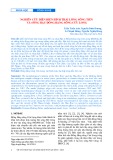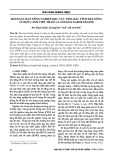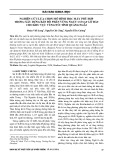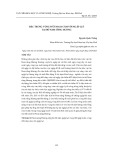
44 Kieu Xuan Tuyen
FLOOD MAPPING WITH IMPACTS OF THE FLOOD RELEASES AND DAM
FAILURE OF LARGE RESERVOIRS IN THE VU GIA - THU BON RIVER BASIN
Kieu Xuan Tuyen*
Central Vietnam Institute for Water Resources - Vietnam Academy for Water Resources, Vietnam
*Corresponding author: kxtuyen@gmail.com
(Received: September 13, 2024; Revised: October 09, 2024; Accepted: October 10, 2024)
DOI: 10.31130/ud-jst.2024.555E
Abstract - Natural hazards are unusual natural phenomena that
can cause damage to people, property, the environment, living
conditions, and socio-economic activities. Currently, across the
country, efforts are being made to prevent and control natural
disasters. However, the damage caused by these natural disasters
and floods tends to increase, and unusual phenomena become
more and more extreme due to the following factors: global
climate change, deforestation, and economic development that
accelerates urbanization, industrialization, and the conversion of
forest land into farmland. Floods and dam safety in river basins
have been and are issues of social concern. Practical requirements
in disaster reduction toward proactively responding to adverse
situations that may occur in cases of flood discharge or dam
failure and developing emergency response plans for floods in
river basins to minimize the flood risks.
Key words - Vu Gia-Thu Bon; flood map; GIS; flood discharge;
dam failure.
1. Introduction
Vietnam has one of the largest irrigations and
hydropower infrastructure systems in the world.
According to the report on the irrigation and hydropower
reservoirs from the Ministry of Agriculture and Rural
Development in 9/2024 [1], there are 6,842 water
reservoirs across the country. Among these, there are
62 reservoirs with a capacity of over 100 million m3,
131 reservoirs ranging from 10 million to 100 million m3,
92 reservoirs with capacities between 5 million and
10 million m3, 100 reservoirs holding between 3 million
and 5 million m3, and 471 reservoirs containing between
1 million and 3 million m3, the majority of the reservoirs
having capacities less than 1 million cubic meters, with
most being earthen dams. In recent years, rainfall and
flooding patterns have become increasingly complex and
unpredictable, coupled with the construction of numerous
hydropower and irrigation projects aimed at economic
development, which has led to a rise in emergency flood
releases and dam failures, causing significant losses in
human life and property. Therefore, modeling flood
scenarios downstream of reservoirs due to emergency
releases or dam failures is critical for effective disaster
preparedness and response planning. The study results
will provide a scientific basis for developing
recommendations and strategies for evacuating
populations in downstream areas, thereby ensuring safety
for both individuals and property during unforeseen
events.
This paper presents findings focused on constructing
flood maps corresponding to various scenarios of flood
releases and dam failures, as part of the state-level
independent project coded ĐTĐL.CN-84/21: "Research on
building emergency response plans for the possibility of
major floods and dam breaks on the Vu Gia - Thu Bon
River basin".
These findings will significantly contribute to
establishing essential scientific arguments for formulating
proactive disaster response strategies in the event of
emergency flood releases or dam failures from large
reservoirs within the Vu Gia - Thu Bon River basin,
thereby aiding in guiding development planning and
stabilizing socio-economic conditions in Quang Nam
Province and Da Nang City.
2. Research area overview
The Vu Gia - Thu Bon River System is a major river
system located in the Central Coast region of Vietnam,
with a river basin area of 10,350 km². Within this area,
301.7 km² is located in Kon Tum Province, while the
majority lies in Quang Nam Province and Da Nang City.
This river basin serves as the most important water source
for meeting the socio-economic development needs of both
Quang Nam Province and Da Nang City.
In this basin, there are approximately 1,275 water
reservoirs, of which 1,202 are located in Quang Nam
Province and 73 in Da Nang City (as reported in the
Quang Nam and Da Nang Province Planning Report for
the 2021-2030 period, with a vision towards 2050) [2, 3].
Due to the predominantly mountainous terrain of the Vu
Gia - Thu Bon basin, it presents significant potential for
hydropower development. The total regulation capacity
of reservoirs within this basin is approximately over 4
billion m³.
Figure 1. Map of the Vu Gia - Thu Bon River Basin,
scaled 1:810,000






























